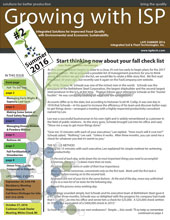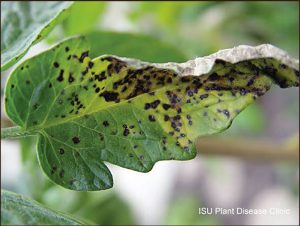

Early Blight and Septoria Leaf Spot are an annual occurrence in tomato fields, greenhouses, and high tunnels. ISP Staff, dealer reps, and field consultants all report high levels of this disease. The high heat and low rainfall earlier this season somewhat slowed these diseases, but the return of rains coupled with lower nighttime temperatures has fired these diseases up. In addition, we are now in the typical summer weather cycle of thunderstorms followed by high humidity that enables and accelerates transmission across the field. Managing these two diseases requires careful attention and timely applications of fungicides. Fortunately, one set of practices and fungicides will manage both diseases and greatly reduce the threat of most other tomato fungal and bacterial diseases.

Both diseases overwinter on plant debris left over from the prior season. Therefore, begin with a good rotation scheme, so that last years’ decaying plant debris is not in the same field as your crop. In a high tunnel or greenhouse, completely remove as much tomato plant and roots as possible at the end of the season, then till the soil thoroughly. Apply ReStore 3G to encourage beneficial microbes and to refresh the soil. The application of a root zone applied biological such as Actinovate, RootShield Plus, or Terra Grow is recommended at planting. Starting a disease management program as soon as possible after transplanting or once the first infection is spotted is very important in slowing the spread of these diseases within a field.
One new tool that ISP Technologies has brought to growers is silicon heavy specialty nutrients. Silicon is not considered a necessary plant nutrient like nitrogen, phosphorus, potassium, copper, iron, calcium, magnesium, etc., but is highly important in creating strong plants that resist lodging. In addition, research done at Rutgers University indicates that increasing plant available silicon directly improves the management of plant diseases such as Powdery Mildew. Silicon in the nutrient stream makes its way to plant cell walls where it makes them better able to resist germinating fungal spores’ ability to penetrate plant tissue and causes disease. Silicon has also been noted to assist plants in resisting insect damage and cope with environmental stresses such as high salts.

ISP Technologies has two products that make the application of silicon just another part of plant nutrition and pest management. SiMag58 is ideal when dealing with magnesium deficiencies which are very common in fruiting plants such as tomatoes, peppers, cantaloupes and watermelons. Its’ got highly available EDTA chelated magnesium along with the maximum dose of potassium silicate. The rate for this material is 1-2 teaspoons per gallon foliarly every 7 – 10 days or 8 – 16 oz per acre per week through the drip. SiGuard is 84% available silicon so it is primarily designed to boost pest management. Apply SiGuard at 1 teaspoon per gallon foliarly. Both materials should be compatible with your current spray program and can be tank mixed with other pest management materials. Always do a jar test prior to using any new tank mix.
Basic Early Blight / Septoria Leaf Spot program: Either Regalia, or clorothalonil (Bravo), or Mancozeb, plus a ‘leaf spot’ specific material such as Aprovia Top (3+7), Cabrio (11), Endura (7), Flint (11), Fontelis (7), Inspire Super (3+9), Priaxor (7+11), Quadris Top (3+11), or Tanos (11+27), plus SiGuard or SiMag58. Be sure to rotate the leaf spot specific materials by FRAC code (the number after each material) to reduce the chances for fungicide resistance. Both Gavel and Zing are newer protectants that already contain mancozeb. Due to the long PHI of mancozeb (*5 days), it and materials containing it are best used early in the season prior to the onset of harvest. Apply these materials every 7 days. Rotating or making an extra application of MetaboliK HV-1, a biostimulant, plus a copper such as Badge or Kocide every 10-14 days will greatly boost the efficacy of any disease management program.
Biologically-based Early Blight / Septoria Leaf Spot Program: Begin by planning on making spray applications every 5 days. Apply Regalia with copper, then 5 days later, apply Actinovate, then 5 days later apply a biostimulant such as MetaboliK HV-1 along with Cease or Companion. Begin at planting and continue all season and include SiMag58 or SiGuard with each application. Boosting this program with fertigation applied biologicals will greatly boost the efficacy of this program. Inject Regalia alternated with Terra Grow, or Actinovate, or RootShield Plus, every other week.
Important note: With all of the recommendations above, read the label thoroughly before making any application. Specific varieties may be sensitive to certain fungicides and any new tank mix should be both jar tested and applied to a small portion of the field prior to complete crop application.
